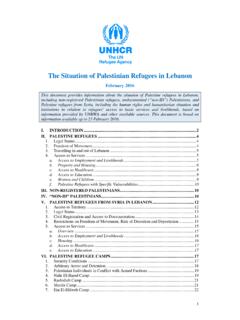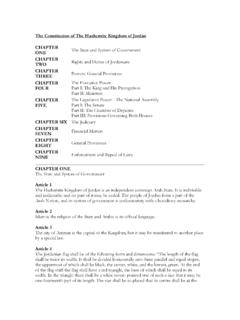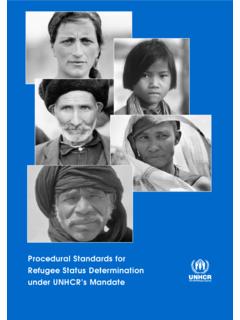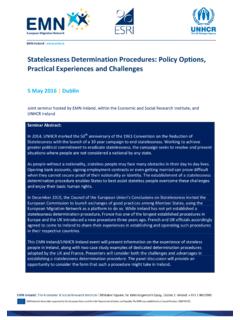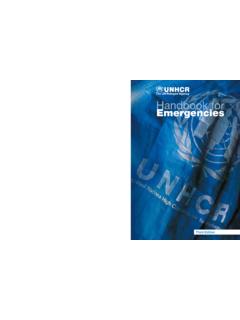Transcription of UNHCR ELIGIBILITY GUIDELINES FOR ASSESSING THE ...
1 UNHCR ELIGIBILITY GUIDELINES FOR ASSESSING . THE international protection needs OF. ASYLUM-SEEKERS FROM AFGHANISTAN. United Nations High Commissioner for refugees ( UNHCR ). 19 April 2016. HCR/EG/AFG/16/02. NOTE. UNHCR ELIGIBILITY GUIDELINES are issued by the Office to assist decision-makers, including UNHCR staff, Governments and private practitioners, in ASSESSING the international protection needs of asylum-seekers. They are legal interpretations of the refugee criteria in respect of specific profiles on the basis of social, economic, security, human rights and humanitarian conditions in the country/territory of origin concerned. The pertinent international protection needs are analysed in detail, and recommendations made as to how the applications in question relate to the relevant principles and criteria of international refugee law as per, notably, the UNHCR Statute, the 1951 Refugee Convention and its 1967 Protocol, and relevant regional instruments such as the 1969 OAU Convention, the Cartagena Declaration and the EU Qualification Directive.
2 The recommendations may also touch upon, as relevant, complementary or subsidiary protection regimes. UNHCR issues ELIGIBILITY GUIDELINES to promote the accurate interpretation and application of the above- mentioned refugee criteria in line with its supervisory responsibility as contained in paragraph 8 of its Statute in conjunction with Article 35 of the 1951 Convention and Article II of its 1967 Protocol and based on the expertise it has developed over the years in matters related to ELIGIBILITY and refugee status determination. It is hoped that the guidance and information contained in the GUIDELINES will be considered carefully by the authorities and the judiciary in reaching decisions on asylum applications. The GUIDELINES are based on in-depth research, information provided by UNHCR 's global network of field offices and material from independent country specialists, researchers and other sources, rigorously reviewed for reliability.
3 The GUIDELINES are posted on UNHCR 's Refworld website at Table of Contents I. EXECUTIVE SUMMARY 4. Refugee Status under the 1951 Convention .. 4. Broader UNHCR Mandate Criteria, Regional Instruments and Complementary Forms of protection .. 5. Internal Flight or Relocation Alternative .. 8. Exclusion Considerations .. 9. II. OVERVIEW OF THE SITUATION IN AFGHANISTAN 10. A. MAIN DEVELOPMENTS IN AFGHANISTAN .. 10. B. THE SECURITY SITUATION IN AFGHANISTAN: IMPACT OF THE CONFLICT ON CIVILIANS .. 14. 1. Civilian 16. 2. Security Incidents .. 18. C. HUMAN RIGHTS SITUATION .. 18. 1. Human Rights Abuses .. 18. a) Human Rights Violations by State Actors .. 19. b) Human Rights Abuses by Pro-Government Armed Groups .. 21. c) Human Rights Abuses by Anti-Government Elements .. 22. 2. The Ability of the State to Protect Civilians from Human Rights Abuses.
4 24. D. HUMANITARIAN SITUATION .. 26. E. CONFLICT-INDUCED DISPLACEMENT .. 28. F. refugees AND RETURNEES .. 31. III. ELIGIBILITY FOR international protection 32. A. POTENTIAL RISK PROFILES .. 34. 1. Individuals Associated with, or Perceived as Supportive of, the Government and the international Community, Including the international Military Forces .. 34. a) Government Officials and Civil Servants .. 35. b) Members of the ANP and ALP .. 36. c) Civilians Associated with or Perceived as Supportive of the ANSF / pro-government forces .. 37. d) Civilians Associated with or Perceived as Supportive of the international Military Forces .. 37. e) Humanitarian Workers and Development Workers .. 38. f) Human Rights 38. g) Other Civilians Perceived as Supporting the Government or the international 38. h) Tribal Elders and Religious 39.
5 I) Women in the Public 40. j) Individuals perceived as Westernized .. 41. k) Family Members of Individuals Associated with, or Perceived as Supportive of, the Government and the international 41. l) Summary .. 42. 2. Journalists and Other Media Professionals .. 42. 3. Men of Fighting Age, and Children in the Context of Underage and Forced Recruitment .. 44. a) Forced Recruitment by AGEs .. 45. b) Forced and Underage Recruitment by Pro-Government Forces .. 46. c) Summary .. 46. 4. Civilians Suspected of Supporting Anti-Government Elements .. 47. 5. Members of Minority Religious Groups, and Persons Perceived as Contravening Sharia 49. a) Minority Religious Groups .. 50. b) Conversion from 53. c) Other Acts Contravening Sharia Law .. 54. d) Summary .. 54. 1. 6. Individuals Perceived as Contravening AGEs' Interpretation of Islamic Principles, Norms and Values.
6 55. 7. Women with Certain Profiles or in Specific Circumstances .. 56. a) Sexual and Gender-Based Violence .. 59. b) Harmful Traditional 60. c) Summary .. 62. 8. Women and Men Who Are Perceived as Contravening Social Mores .. 62. 9. Individuals with Disabilities, Including in Particular Mental Disabilities, and Individuals Suffering from Mental Illnesses .. 65. 10. Children with Certain Profiles or in Specific Circumstances .. 65. a) Bonded or Hazardous Child Labour .. 66. b) Violence against Children, including Sexual and Gender-Based Violence .. 66. c) Systematic Denial of Access to 68. d) Abductions, Punishments and Reprisals by the ANSF and AGEs .. 69. e) Summary .. 70. 11. Survivors of Trafficking or Bonded Labour and Persons at Risk of Being Trafficked or of Bonded Labour .. 70. 12. Individuals of Diverse Sexual Orientations and/or Gender Identities.
7 72. 13. Members of (Minority) Ethnic Groups .. 73. a) Kuchis .. 75. b) 76. c) Members of the Jat ethnic group, including the Jogi, Chori Frosh, Gorbat and Mosuli communities .. 76. d) Land Disputes with an Ethnic or Tribal 77. e) Summary .. 78. 14. Individuals Involved in Blood Feuds .. 78. 15. (Family Members of) Business People and Other People of Means .. 79. B. INTERNAL FLIGHT OR RELOCATION ALTERNATIVE FOR INDIVIDUALS AT RISK OF PERSECUTION .. 81. 1. Relevance Analysis .. 82. 2. Reasonableness Analysis .. 83. C. REFUGEE STATUS UNDER UNHCR 'S BROADER MANDATE CRITERIA OR REGIONAL INSTRUMENTS, OR ELIGIBILITY FOR COMPLEMENTARY FORMS OF protection .. 86. 1. Refugee Status under UNHCR 's Broader Mandate Criteria and Regional Instruments .. 87. a) Refugee Status under UNHCR 's Broader Mandate Criteria .. 87. b) Refugee Status under Article I(2) of the 1969 OAU Convention.
8 88. c) Refugee Status under the Cartagena 89. 2. Internal Flight or Relocation Alternative under UNHCR 's Broader Mandate Criteria and Regional Instruments .. 89. 3. ELIGIBILITY for Subsidiary protection under the EU Qualification 90. 4. Internal protection Considerations for Individuals at Risk of Serious Harm under the EU. Qualification Directive .. 91. D. EXCLUSION FROM international REFUGEE protection .. 91. 1. The Communist Regimes: Former Members of the Armed Forces and the Intelligence/Security Apparatus, Including KhAD/WAD Agents, as well as Former Officials .. 95. 2. Former Members of Armed Groups and Militia Forces During and After the Communist Regimes .. 96. 3. Members of AGEs .. 96. 4. Members of the Afghan Security Forces, including the NDS, the ANP and the ALP .. 97. 5. Members of Pro-Government Paramilitary Groups and Militias.
9 97. 2. List of Abbreviations AAN Afghanistan Analysts Network ABP Afghan Border Police AGEs Anti-Government Elements AIHRC Afghanistan Independent Human Rights Commission ALP Afghan Local Police ANA Afghan National Army ANCOP Afghan National Civil Order Police ANP Afghan National Police ANSF Afghan National Security Forces AREU Afghanistan Research and Evaluation Unit ERW Explosive Remnants of War EVAW Law Law on Elimination of Violence against Women HPC High Peace Council IDP Internally Displaced Person IED Improvised Explosive Device IHL international Humanitarian Law ISAF international Security Assistance Force ISIS Islamic State in Iraq and Syria KIS Kabul Informal Settlements NATO North Atlantic Treaty Organization NDS National Directorate of Security NGO Non-Governmental Organization NUG National Unity Government OAU Organization of African Unity (succeeded by the AU).
10 OCHA United Nations Office for the Coordination of Humanitarian Affairs OHCHR Office of the United Nations High Commissioner for Human Rights RSM Resolute Support Mission UN United Nations UNAMA United Nations Assistance Mission in Afghanistan UNDP United Nations Development Programme UNHCR United Nations High Commissioner for refugees UNICEF United Nations Children's Fund 3. I. Executive Summary These GUIDELINES supersede the August 2013 UNHCR ELIGIBILITY GUIDELINES for ASSESSING the international protection needs of Asylum-Seekers from They are issued against a background of continuing concerns about the security situation in parts of Afghanistan and about widespread human rights abuses. They contain information on particular profiles of persons for whom international protection needs may arise in the current context in Afghanistan.


